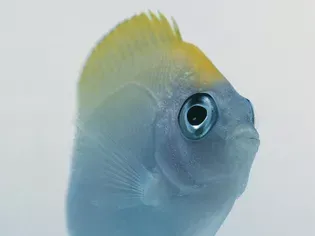Swallowtail Angelfish: Fish Species Profile
Updated on 04/26/24

Swallowtail Angelfish: An Enchanting Fish for Your Saltwater Aquarium
The swallowtail angelfish is a captivating and vibrant marine species that has adorned saltwater aquariums worldwide. With its striking colors, elegant fins, and intriguing behavior, this angelfish species captivates the hearts of aquarium enthusiasts.
Distinctive Appearance and Coloration
Swallowtail angelfish are instantly recognizable by their vibrant coloration and distinctive fin shape. Their bodies are typically adorned with a deep blue or purple base hue, adorned with intricate patterns of yellow or orange. The most captivating feature, however, is their elongated dorsal fin, which gracefully extends beyond their body, resembling a flowing swallow's tail.
Ideal Habitat and Aquarium Requirements
As a tropical reef fish, swallowtail angelfish thrive in warm, well-oxygenated waters with ample hiding places. To provide an optimal habitat in captivity, a spacious aquarium of at least 75 gallons is recommended, along with:
- Temperature: 75-82°F (24-28°C)
- pH: 8.1-8.4
- Salinity: 1.023-1.025 SG
- Lighting: Moderate to bright
- Current: Moderate
- Hiding places: Live rock, PVC pipes, or caves
Feeding and Dietary Needs
In their natural habitat, swallowtail angelfish feed primarily on small invertebrates such as sponges, tunicates, and algae. In captivity, they can be fed a varied diet consisting of:
- Live foods: Brine shrimp, mysis shrimp, live plankton
- Frozen foods: Krill, squid, chopped fish
- Prepared foods: High-quality angelfish pellets or flakes
Behavior and Compatibility
Swallowtail angelfish are generally peaceful and non-aggressive towards other fish species, making them suitable for community aquariums. However, they can be territorial with other angelfish species, particularly within the genus Centropyge.
Their behavior is characterized by:
- Swimming: They are active swimmers, often found in the mid- to upper levels of the aquarium.
- Feeding: They are voracious eaters and may require multiple feedings per day.
- Hiding: They retreat to crevices or under overhangs when startled or sleeping.
Captive Breeding
Captive breeding of swallowtail angelfish has been successfully achieved in some instances. However, it requires specialized conditions, including:
- Mature breeding pair: A male and female that have previously spawned together.
- Species-only breeding tank: To avoid aggression from other fish species.
- Optimal water parameters: Ideal temperature, pH, and salinity.
- Triggering factors: Providing live food, algae growth, or hormonal injections may stimulate spawning.
Diseases and Health Concerns
Like other marine fish, swallowtail angelfish can be susceptible to various diseases, including:
- Bacterial infections: Fin rot, saltwater ich
- Parasitic infections: Marine ich, velvet disease
- Environmental stress: Ammonia or nitrite poisoning
- Nutritional deficiencies: Vitamin or mineral deficiencies
Maintaining optimal water quality and providing a nutritious diet are crucial for preventing health issues. Regular quarantine procedures and timely veterinary assistance are also essential for safeguarding the health of your swallowtail angelfish.
Conclusion
The swallowtail angelfish is a captivating and rewarding addition to any saltwater aquarium. Its vibrant coloration, elegant fins, and intriguing behavior add beauty and fascination to the underwater environment. With proper care and attention, this species can thrive in captivity for many years, bringing joy and wonder to aquarium enthusiasts and observers alike.
Explore More Pets

Freshwater Aquarium Filters
How to Deal With Cloudy Aquarium Water

Saltwater Aquarium Filters
How Do You Remove Chloramines From Tap Water?

Freshwater Aquariums & Habitat
Can I Keep My Koi Fish Inside?

Saltwater Aquariums & Habitat
14 Best Floating Plants for Your Aquarium

Freshwater Fish Health
How to Treat Ich on Freshwater Fish

Saltwater Fish Health
Fin Rot in Aquarium Fish

Freshwater Aquarium Filters
How to Do Aquarium Water Changes

Saltwater Fish Health
How Do Fish Get Parasites?